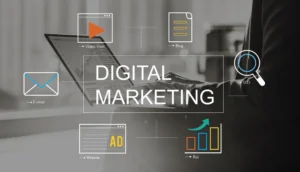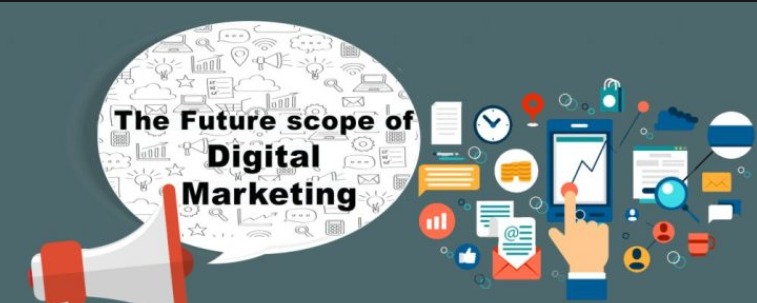Scope For Digital Marketing in India
1. Overview of Digital Marketing in India,Scope For Digital Marketing in India
A. Importance of digital marketing, Scope For Digital Marketing in India
- A. Reach and Targeting:
- Wide audience reach: Digital marketing allows businesses to reach a global audience through various digital channels such as search engines, social media, websites, and email.
- Targeted marketing: Digital marketing enables precise targeting based on demographics, interests, behaviors, and preferences, ensuring that marketing efforts reach the right audience, leading to higher conversion rates.
- B. Cost-Effectiveness: Scope For Digital Marketing in India
- Affordable compared to traditional marketing: Digital marketing campaigns can be implemented at a fraction of the cost of traditional marketing methods like TV or print ads, making it accessible to businesses of all sizes, including startups and small businesses.
- Performance-based expenditure: Digital marketing offers the advantage of performance tracking, allowing businesses to measure the effectiveness of their campaigns in real-time and optimize their marketing budgets accordingly.
- C. Measurable Results: Scope For Digital Marketing in India
- Data-driven insights: Digital marketing provides detailed analytics and data on customer behavior, engagement, conversions, and ROI. This data helps businesses make informed decisions and refine their marketing strategies for better results.
- Tracking and monitoring: Digital marketing platforms offer tools and metrics to monitor the performance of campaigns, measure key performance indicators (KPIs), and make data-driven adjustments for continuous improvement.
- D. Personalization and Customer Engagement: Scope For Digital Marketing in India
- Customized messaging: Digital marketing allows businesses to personalize their marketing messages and offers, creating a more tailored and relevant experience for customers.
- Interactive engagement: Digital platforms offer various engagement options like comments, likes, shares, and reviews, fostering two-way communication and building stronger relationships with customers.
- E. Brand Building and Awareness:
- Online presence: Digital marketing helps businesses establish and enhance their online presence through website development, search engine optimization (SEO), and social media engagement, increasing brand visibility and recognition.
- Brand storytelling: Digital marketing channels provide opportunities to tell compelling brand stories, showcase products/services, and create a unique brand identity, resonating with target audiences.
- F. Adaptability and Flexibility:
- Quick adjustments: Digital marketing allows businesses to make real-time adjustments to campaigns, content, and messaging based on customer feedback and market trends, ensuring relevance and agility.
- Multiple platforms and formats: Digital marketing encompasses various channels and formats like websites, social media, email, video, and mobile, offering flexibility to businesses to choose the most suitable platforms for their target audience.

B. Key factors driving the growth of Digital Marketing in India, Scope For Digital Marketing in India
- A. Increasing Internet Penetration:
- Rapid growth of internet users: India has witnessed a significant increase in internet penetration, with over 624 million internet users as of January 2021.
- Growing smartphone adoption: The availability of affordable smartphones and affordable data plans has led to a surge in mobile internet usage, making digital marketing accessible to a large portion of the population.
- B. E-commerce Boom:
- Rise in online shopping: The e-commerce industry in India has experienced tremendous growth, driven by factors such as convenience, competitive pricing, and a wide range of product choices.
- Demand for digital marketing in e-commerce: Online businesses heavily rely on digital marketing strategies to drive website traffic, improve conversions, and enhance customer experience.
- C. Social Media Explosion: Scope For Digital Marketing in India
- Increasing social media usage: Social media platforms such as Facebook, Instagram, Twitter, and YouTube have gained immense popularity in India, with a large user base actively engaging on these platforms.
- Opportunities for brand promotion: Social media offers a powerful avenue for businesses to connect with their target audience, build brand awareness, and engage in direct conversations with customers.
- D. Digital Advertising Shift:
- Shift from traditional to digital advertising: Companies are allocating a significant portion of their advertising budgets to digital platforms due to their ability to target specific audiences, provide measurable results, and offer cost-effective solutions.
- Growth of programmatic advertising: The adoption of programmatic advertising, which uses algorithms and automation to buy and optimize ad placements, has further fueled the growth of digital advertising in India.
- E. Government Initiatives: Scope For Digital Marketing in India
- Digital India campaign: The Indian government’s Digital India initiative aims to transform India into a digitally empowered society and knowledge economy. This has led to increased digital infrastructure development, connectivity, and digitization of government services, creating a favorable environment for digital marketing.
- Start-up and entrepreneurial support: The Indian government has implemented various programs and policies to promote entrepreneurship, innovation, and the growth of start-ups, which has positively impacted the digital marketing landscape.
- F. Technological Advancements:
- Mobile technology advancements: The widespread availability of smartphones, affordable mobile data plans, and improving internet speeds have facilitated increased mobile internet usage, opening up new opportunities for mobile-focused digital marketing strategies.
- Innovations in data analytics and AI: Advancements in data analytics, artificial intelligence (AI), and machine learning (ML) technologies have enabled businesses to gather and analyze large volumes of data, gain valuable insights, and deliver personalized marketing experiences.

2. Large and Growing Internet User Base
A. Increasing smartphone adoption and mobile internet usage
- I. Increasing Smartphone Adoption
- A. Affordability and availability:
- 1. Declining smartphone prices: The Indian market has witnessed a significant reduction in smartphone prices, making them more affordable and accessible to a larger population.
- 2. Diverse smartphone options: A wide range of smartphone models, including budget-friendly options, cater to various consumer segments, further boosting adoption rates.
- B. Rising smartphone ownership:
- 1. Growing ownership across demographics: Smartphone ownership has expanded beyond urban areas and penetrated rural and semi-urban regions as well.
- 2. Younger population as early adopters: The younger demographic in India has shown a higher inclination towards smartphone adoption, contributing to the overall growth.
- C. Internet connectivity:
- 1. Availability of mobile internet services: Telecom operators have expanded their networks, providing improved mobile internet connectivity across the country.
- 2. Accessibility in remote areas: Mobile internet has reached remote and previously underserved areas, enabling people to access online content and services.
- II. Mobile Internet Usage
- A. Increase in mobile data consumption:
- 1. Decreasing data costs: Competitive pricing and affordable data plans have made mobile internet usage more accessible and affordable for users.
- 2. Higher data allowances: Telecom operators are offering larger data allowances and unlimited plans, encouraging users to consume more data.
- B. Social media and entertainment consumption:
- 1. Social media platforms: Popular social media platforms like Facebook, Instagram, Twitter, and TikTok have experienced substantial growth in India, with users spending a significant amount of time on these platforms.
- 2. Video streaming and online entertainment: The rise of video streaming platforms such as YouTube, Netflix, Amazon Prime Video, and Hotstar has led to increased mobile internet consumption for entertainment purposes.
- C. Mobile app usage:
- 1. App-centric culture: Indians are increasingly relying on mobile apps for various activities, including shopping, banking, food delivery, transportation, and communication.
- 2. App penetration in diverse sectors: Mobile apps have become integral to sectors such as e-commerce, travel, healthcare, education, and finance, leading to increased mobile internet usage.
- III. Implications for Digital Marketing
- A. Mobile-optimized experiences:
- 1. Responsive web design: Businesses need to ensure that their websites are mobile-friendly and optimized for a seamless user experience across different screen sizes.
- 2. Mobile app presence: Developing and promoting mobile apps can help businesses engage with customers directly and provide personalized experiences.
- B. Mobile advertising:
- 1. In-app advertising: Mobile apps provide opportunities for businesses to display targeted ads within popular apps, reaching users during their mobile internet sessions.
- 2. Location-based marketing: Mobile devices enable location tracking, allowing businesses to deliver location-specific ads and offers to users in real-time.
- C. Mobile-focused content and strategies:
- 1. Short-form and visually appealing content: Optimizing content for mobile consumption, such as short videos, infographics, and visually appealing imagery, can enhance engagement.
- 2. Mobile-first campaigns: Developing marketing campaigns with a primary focus on mobile platforms can help businesses capitalize on the growing mobile internet usage.
- In summary, the increasing adoption of smartphones and mobile internet usage in India has opened up vast opportunities for businesses to leverage digital marketing strategies. By understanding and adapting to the mobile-centric preferences of consumers, businesses can effectively reach and engage with their target audience in this evolving digital landscape.

B. Opportunities to reach and engage with a vast online audience
- I. Wide Online Audience Reach
- A. Large user base: With over 624 million internet users, India has one of the largest online populations globally, providing a vast pool of potential customers.
- B. Diverse demographics: The online audience in India spans various demographics, including age groups, income levels, and geographic regions, offering businesses the chance to target specific segments.
- C. Accessible across devices: The online audience can be reached through multiple devices, including smartphones, tablets, laptops, and desktops, ensuring a broader reach.
- II. Digital Advertising Platforms
- A. Search engine advertising: Platforms like Google Ads provide businesses the opportunity to display targeted ads to users searching for relevant keywords, increasing visibility and attracting potential customers.
- B. Social media advertising: Popular social media platforms like Facebook, Instagram, Twitter, and LinkedIn offer extensive advertising options to target specific audiences based on demographics, interests, behaviors, and more.
- C. Display advertising: Display networks and programmatic advertising platforms enable businesses to place visually appealing ads on relevant websites and apps, reaching a wider online audience.
- III. Content Marketing and SEO
- A. Valuable content creation: Developing high-quality and relevant content, such as blog articles, videos, infographics, and guides, helps attract and engage online users, establishing thought leadership and building brand loyalty.
- B. Search engine optimization (SEO): Optimizing website content and structure for search engines enhances organic visibility, allowing businesses to appear in relevant search results and drive targeted traffic to their websites.
- IV. Social Media Engagement
- A. Building brand presence: Social media platforms provide opportunities to create brand awareness, engage with customers, and share updates and offers.
- B. Influencer partnerships: Collaborating with social media influencers who have a significant following in specific niches can expand brand reach and credibility.
- V. Email Marketing
- A. Direct communication channel: Email marketing allows businesses to reach their audience directly, delivering personalized messages, promotions, and updates.
- B. Building customer relationships: Engaging with customers through personalized email campaigns helps nurture relationships and drive conversions.
- VI. Video Marketing
- A. Growing popularity: Video content consumption is on the rise in India, presenting opportunities for businesses to create engaging video ads, tutorials, product demos, and brand storytelling.
- B. Video platforms and streaming services: Leveraging platforms like YouTube, TikTok, and OTT (over-the-top) streaming services allows businesses to reach a massive online audience through targeted video campaigns.
- VII. Mobile Marketing
- A. Mobile apps and SMS marketing: Developing mobile apps and utilizing SMS marketing enables businesses to engage with users directly on their smartphones, providing personalized offers and notifications.
- B. Location-based targeting: Leveraging location data, businesses can deliver targeted ads, offers, and promotions to users based on their geographical proximity.
- VIII. Analytics and Personalization
- A. Data-driven insights: Leveraging analytics tools and data, businesses can understand customer behavior, preferences, and demographics, allowing them to tailor marketing efforts for better engagement and conversions.
- B. Personalization and remarketing: Utilizing data, businesses can deliver personalized recommendations, offers, and advertisements to users based on their browsing history and previous interactions.
3. Digital Advertising Market
A. Rise of digital advertising expenditure in India
- I. Increasing Digital Advertising Market Size
- A. Growing market value: The digital advertising market in India has experienced substantial growth, with increasing investments from businesses across various industries.
- B. Competitive landscape: The market is witnessing intense competition among digital advertising platforms, service providers, and agencies, reflecting the rising demand for digital advertising solutions.
- II. Shift from Traditional to Digital Advertising
- A. Allocation of budgets: Businesses are increasingly allocating a larger portion of their advertising budgets to digital platforms, recognizing the effectiveness and reach of online advertising compared to traditional channels.
- B. Decline in traditional media spending: Traditional advertising mediums such as television, print, and radio have witnessed a slowdown in growth rates, with advertisers shifting their focus towards digital channels.
- III. Factors Driving Digital Advertising Expenditure Growth
- A. Increasing internet and mobile penetration: The rise in internet users and smartphone adoption has expanded the potential reach of digital advertising, prompting businesses to invest more in online campaigns to target the growing online audience.
- B. Growing e-commerce industry: The booming e-commerce sector in India has fueled the need for digital advertising to drive traffic, conversions, and sales for online businesses.
- C. Social media dominance: The popularity of social media platforms, particularly among the younger demographic, has attracted businesses to invest in social media advertising to connect with their target audience effectively.
- D. Measurability and ROI: Digital advertising provides more accurate and measurable data on campaign performance, enabling businesses to evaluate the return on investment and optimize their marketing strategies accordingly.
- IV. Digital Advertising Platforms and Formats
- A. Search engine advertising: Businesses leverage search engine advertising platforms like Google Ads to display targeted ads based on users’ search queries, driving relevant traffic and conversions.
- B. Social media advertising: Popular social media platforms such as Facebook, Instagram, Twitter, and LinkedIn offer robust advertising solutions, allowing businesses to reach their target audience with precision and engage them effectively.
- C. Programmatic advertising: The adoption of programmatic advertising, powered by automation and data-driven targeting, has gained traction in India, offering efficiency, scalability, and cost-effectiveness for ad campaigns.
- D. Video advertising: The rise of video streaming platforms and the popularity of video content consumption have led to increased investment in video advertising, both on platforms like YouTube and through in-app video ads.
- E. Native advertising: Native advertising formats, seamlessly integrated into the user experience of websites and apps, have gained popularity due to their ability to deliver non-intrusive and contextually relevant brand messages.
- V. Government Regulations and Industry Guidelines
- A. Monitoring and compliance: The government and industry bodies have been actively monitoring digital advertising practices, promoting transparency, consumer protection, and fair competition in the digital advertising ecosystem.
- B. Data privacy and consent: The implementation of regulations like the Personal Data Protection Bill emphasizes the importance of user consent and data privacy, influencing how digital advertising is conducted in India.
B. Shift from traditional to digital advertising channels
- I. Effectiveness and Reach
- A. Targeted audience: Digital advertising allows businesses to target specific audience segments based on demographics, interests, behaviors, and online activities, resulting in more precise and effective ad placements.
- B. Wide reach: Digital platforms provide access to a vast online audience, including internet users across different age groups, geographic locations, and interests, enabling businesses to reach a broader customer base compared to traditional channels.
- II. Measurability and ROI Tracking
- A. Data-driven insights: Digital advertising provides detailed analytics and reporting tools, allowing businesses to measure the performance of their campaigns in real-time. Metrics like impressions, clicks, conversions, and customer engagement provide valuable insights for optimization and decision-making.
- B. Return on investment (ROI): The ability to track and analyze campaign results enables businesses to assess the effectiveness of their digital advertising efforts and optimize their strategies for better ROI.
- III. Cost-Effectiveness
- A. Flexible budgets: Digital advertising platforms often offer flexibility in budget allocation, allowing businesses to start with smaller budgets and scale up based on performance.
- B. Lower costs: Digital advertising, especially on platforms like social media and search engines, often offers cost-effective options compared to traditional channels like TV, radio, and print, making it more accessible to businesses of all sizes.
- IV. Interactive and Engaging Formats
- A. Rich media: Digital advertising offers a wide range of interactive and engaging formats such as videos, images, animations, and interactive elements, enhancing user experience and capturing attention.
- B. Two-way communication: Digital channels enable businesses to engage with their audience through features like comments, likes, shares, and direct messaging, fostering dialogue and building relationships.
- V. Real-Time Optimization
- A. A/B testing: Digital advertising allows businesses to experiment with different ad variations, messages, and targeting strategies to identify the most effective combinations. Real-time optimization helps refine campaigns and maximize results.
- B. Quick adjustments: Unlike traditional advertising, digital advertising allows businesses to make quick adjustments to their campaigns, modifying ad creatives, targeting parameters, and budgets to adapt to changing market dynamics and audience preferences.
- VI. Integration with Other Digital Strategies
- A. Synergy with content marketing: Digital advertising can complement content marketing efforts by amplifying the reach of valuable content and driving traffic to owned media channels like websites, blogs, and social media profiles.
- B. Cross-channel integration: Digital advertising can be seamlessly integrated with other digital marketing channels such as email marketing, social media marketing, and search engine optimization (SEO), creating cohesive and impactful campaigns.
- VII. Mobile-Centric Approach
- A. Mobile device usage: With the widespread adoption of smartphones, mobile has become a primary channel for accessing digital content. Digital advertising allows businesses to reach consumers on their mobile devices, leveraging the opportunities presented by mobile apps and responsive websites.
- B. Location-based targeting: Mobile advertising enables businesses to deliver targeted ads based on users’ geographical location, providing hyper-local and contextually relevant messaging.


